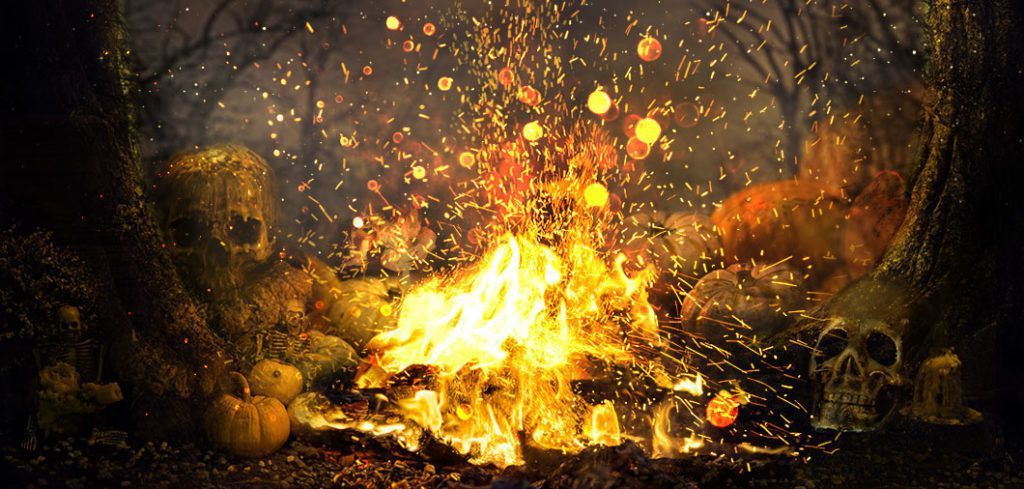October is here! Mother nature welcomes us to a new cycle and it had a lot to do with Halloween. At the beginning of October, we say goodbye to autumn and prepare for the winter season. This seasonal transition is an uncanny one. Halloween adorns the end of this eeriness month. You may also call it the Sabbath by its old name. But what is Samhain Sabbath? And what is its relationship with Halloween?
What is Samhain?
Samhain was a pagan religious festival that comes from an ancient Celtic spiritual tradition. Samhain meaning is based on the Old Irish word; Samain. This word is thought to derive from the pre-Indo-European root *semo- (“summer”), which means “end of summer”.

Samhain days started in October and at the end of the month, a big festival celebrated to herald the harvest and the dark half of the year. It marked end of the harvest season and the beginning of winter; but it was also period of change. Celts believed that during this transition, the the border between the dead and the living world was the thinnest. And on the night of October 31, the veil between two world gets transparent. The ancient Celts also adopted it as the most important of the quarterly fire festivals, which take place at the midpoint between the Autumnal Equinox and the Winter solstice.
Samhain History
Most people think Samhain is the origin of Halloween, but for many modern Pagans, it is considered a Sabbath to honor the ancestors who came before us and signify the dark time of the year. Sabbaths are holy days that herald the cycle of nature. Eight holy days and festivals, according to the Wheel of the Year cycle are;
- Winter Solstice – (Yule)
- Imbolc (Candlemas)
- Spring Equinox (Ostara)
- Beltane (May Eve)
- Summer Solstice (Litha)
- Lughnasadh (Lammas)
- Autumn Equinox (Mabon)
- Samhain (Halloween)
For the Celts living in the Iron Age, the Samhain festival was kind of a New Year’s celebration. It symbolizes the end of the harvest month and the arrival of cold and dark winter. Like rebirth, so it was a big deal.
View this post on Instagram
The end of summer meant the death of light. Imagine how frightening the long nights and harsh weather conditions can be! It is not surprising that our ancient ancestors believed that the dead could visit the world during this period. So maybe, it can be said that Samhain was some kind of a Celtic Halloween. In this respect, Samhain may indeed have inspired Halloween.
Immigrants from Scotland and Ireland to America are likely to have carried these ancient Samhain traditions to the new continent. In this way, Samhain, an ancient Sabbath, was able to preserve its existence until modern times.
From the Celts to the Present
It was not easy to completely abolish such a deep-rooted festival, even for the church. First, Papa Boniface changed the date of Samhain. But there were still fire festivals in October and November – so that didn’t work. Later, Papa Gregory moved Samhain back to its old date, but did a little trick and changed its name. The first of November was no longer Samhain, but “Saints’ Day”. The second of November would be the “Spirit’s Day” and October 31st was the eve of these two holidays, and it was called “All Hallows Eve”! This name would shorten over time and become “Halloween”. Thus, Samhain had to change according to Christian beliefs.

Samhain’s transformation into Halloween and its commercialization coincide with the early 1900s. Postcards and various decorations began to appear before World War I and Halloween costumes made their way into stores in the 1930s. The famous trick-or-treat question became common in the 1950s.
Born of the Pagan Halloween
Yes, actually Samhain was just a tribute to the fascinating workings of nature. The end of summer and the transition to winter; when harsh weather conditions came. Imagine how difficult it must have been for people in the Iron Age to survive those conditions. Hence, it is not so absurd that the end of summer reminds them dead.
But how this Pagan holiday turned into a universally loved celebration? The answer to that question is in; Halloween Origins and Traditions blog post.
Happy Samhain everone!
